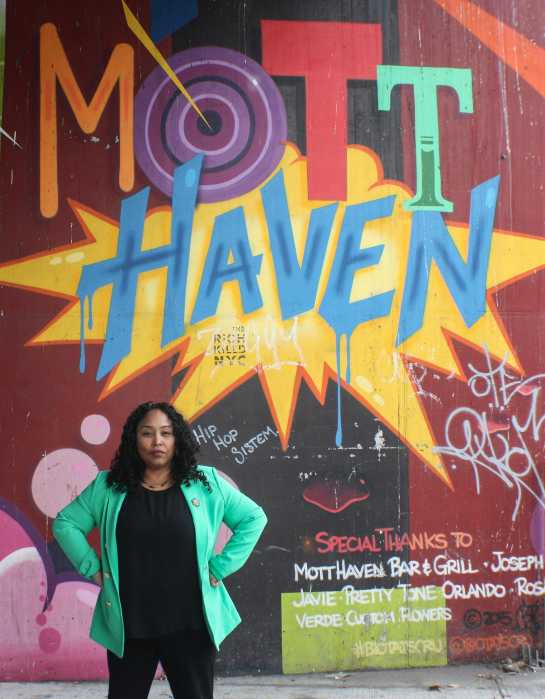By Nicole Davis
Brooke Singer was looking to burn a bucket of coal. She figured if she had the coal to burn, it would produce noxious pollutants we can’t see, but that Singer would be able to detect using a portable air-monitoring device, a gadget her colleagues created. Like an electronic nose, the device senses pollutants in its vicinity. And nothing says “pollutant” quite like coal — which is why Singer wanted a bagful.
She looked in the yellow pages, under Coal. She called all over New York. And ultimately, the dealer, the only man who still sells coal in the city — mainly to pizza parlors with coal-fired ovens — was around the corner from her apartment in Queens. So Singer bought 20 pounds worth, equal to what the average person burns in a day, and brought it back to a storefront on Maiden Lane, where, last Thursday, the digital media artist and her colleagues, Beatriz da Costa and Jamie Schulte of Preemptive Media, were on hand to greet visitors at the opening of “Area’s Immediate Reading,” or AIR. The public art exhibition allowed people to use the air-monitoring devices, and take some readings of their own. Only there was no burning coal.
“We had landlord issues,” said Singer, standing on the sidewalk as passersby stopped to check out the air monitoring device, which looks like a hi-tech Viewmaster. “They didn’t want us to burn anything,” she said, adding, “We shouldn’t have asked them.”
It was a minor glitch, ultimately, in a project that was intended to give the public hands-on tools to talk about air quality — particularly in Lower Manhattan, where it’s been a cause for concern ever since 9/11. That great unknown served as the original inspiration for AIR, which was made possible by a Social Sculpture Commission from the Eyebeam Art and Technology Center in Chelsea and the Lower Manhattan Cultural Council. Billed on Preemptive Media’s website as a “public, social experiment,” it’s just one of the collective’s public art projects, which typically have an artistic, tech, and activist component. (Their last one, “Swipe,” involved setting up a bar in museums, taking customer’s driver licenses with their drink orders, swiping its magnetic strip and then handing back a receipt printed with their personal information — a thought-provoking comment on privacy and the collection of personal data.)
“We’re opening up a dialogue, so people can learn the vocabulary of air quality with us,” Singer said before the project launched. “So when people say ‘oh, the air is safe to breathe,’ you don’t have to take their word for it.” (Nor do people have to rely on data from the limited number of fixed pollution sensors in the city: they simply take their monitors with them and go.)
With the help of Eyebeam, Singer made analyzing air quality easy by creating color-coded visuals that pop up on the devices’ screens when you point one downward. A sensor within the AIR device detects carbon monoxide and nitrogen oxides in the surrounding air, and then a sphere of color starts to appear on the screen: polluted air is terror-alert red, clean air is blue, and shades of orange and yellow fall somewhere in between.
It’s a neat trick—but Preemptive Media took it a few steps further. First, they installed cell phone technology in each device, which transmits these colored, individual readings to a central server, and onto the AIR website, where the data appears as a colorful map of the city’s air quality. A GPS receiver was also added to the hardware, along with coordinates of the city’s major polluters, so when you point the device up, you can spot how close one of these serious offenders lies in relation to you. (Some of the more surprising polluters include Columbia University and Hugo Neu, which handles the city’s metal, plastic, and glass recycling.)
And if another person is holding one of these gadgets near you, you can spot them, also. Individual devices can even be tracked online, so long as the holder is willing to be “detected” around town.
To appreciate all this sensing wizardry, imagine putting ten of these devices into the hands of ten different New Yorkers, who then take them to their homes, and send back readings from all over the boroughs. Now imagine if these people pass their devices onto ten different people, who then take readings in their neighborhoods, and so on, until that online snapshot of air quality gets more and more colorful and complex.
It’s a fascinating picture — in theory. In reality, the ten devices PM thought they would be able to hand out last Thursday were not all ready by the time of the opening. But the two they had were in high demand.
“I read about this in the New Scientist,” said one eager AIR participant, a studious-looking man who had his friend, a recording engineer from Portland, Oregon, in tow. Together they tried to make sense of the AIR device, first pointing it up, then growing impatient at the non-existent GPS reading before pointing it down. Bored by the blue dot that appeared on the screen — which indicated the air was good — they took the device across the street, and stuck it beneath the tailpipe of an undercover cop car that was idling. The officer drove away before they could get a new read.
But inside the tiny storefront on Maiden Lane that served as AIR’s temporary headquarters until this Thursday, the dot on the device’s screen turned from blue to yellow, indicating a decrease in air quality.
When asked why the air inside was worse than the air outside, Singer’s colleague, Beatriz da Costa, explained that the sensors pick up other pollutants, too. So what it was detecting could be carbon monoxide. “Or it could just be carpet glue,” she said, which sparked a conversation about just how healthy it was to be breathing in the room’s air.
There were a few other bugs in the rollout of AIR, like defective batteries. But Singer was quick to point out that AIR was created by tech-savvy artists — not Hewlett-Packard. “We’re not a major corporation that takes three years and spends millions of dollars to develop a product,” she said. “Though this project is definitely in its beta phase.”
She expects the kinks will be worked out by this Monday, September 25, at which point all ten devices should be ready to be distributed to the 100 people who signed up to be part of AIR online. Watch for the results at www.pm-air.net.


































